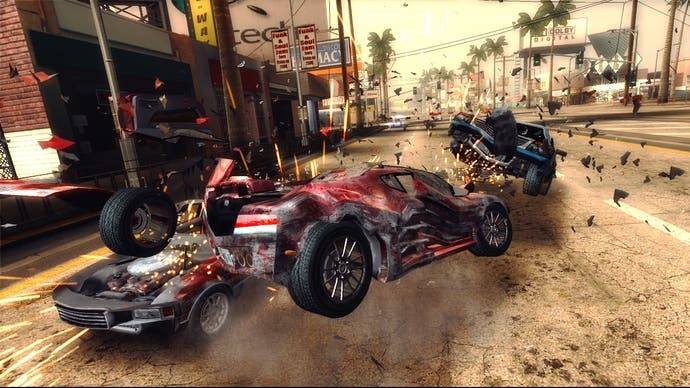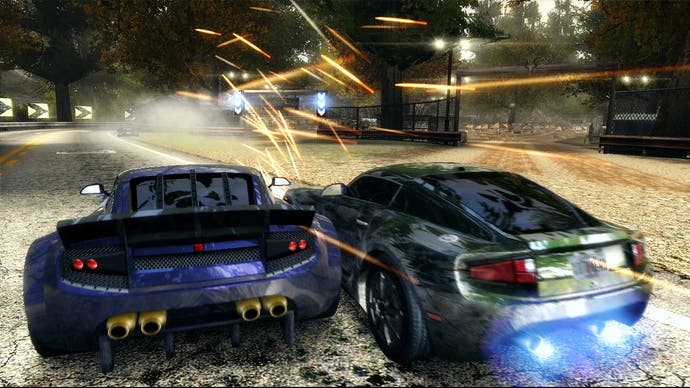Burnout: Revenge
For once, it's all about the new features.
To riff rather unashamedly on something Jim wrote recently, there's something dishonest about that Friends list. "When you're on Live, there are always people who want to fxxk it up," says Burnout producer Matthew Webster. Or who beat you. Or test your patience with their anodyne smack-talk. Funnily, quite a few of them are already on my Friends list. As for the others - last week I was playing PGR3 against an American chap who spent most of the race asking me whether I'd ever driven before, whether we had the wheel over here in Scotland (I'm in London, but let's not get side-tracked), and if I could give the pad back to my son please MOOOOOM; ten minutes after I said goodbye, he sent me a Friends request. Eh?
To get back to Webster though: "and Burnout is all about fxxking things up."
That mentality's very much at the core of the new Xbox 360 version's Live Revenge feature. Having spent some time brainstorming the possibilities for expanding Revenge's Live implementation on 360, Criterion figured honesty was the best policy. "It's not your Friends list now, it's your enemies list," Webster sound-bites with a smile. He's not wrong though: Live Revenge keeps track of people who've secured Takedowns by forcing you to crash or smashing you to bits during races, and points them out when you run into them next time, giving you the chance to settle the score by, er, running into them next time. In the case of players who continually cane you, you might even pick up an archrival. Taking rivals down for victory gives you a satisfying "Score Settled!" notification. We particularly like the idea of betraying people on our team to settle a score. Oh, and they haven't trademarked the "enemies list" thing, Mr Cynic.

Hang about though. An Xbox 360 port with new features?
Yes indeed. "We want Burnout: Revenge on Xbox 360 to be the showcase version," says Webster. That means reworked graphics, sound, ten new Crash junctions not possible on Xbox 1, tweaks to existing tracks, balance adjustments and sundry other changes designed to make the 360 version as complete as possible. There's always going to be an argument about the wisdom/tactlessness of releasing an improved Xbox 360 version less than six months after the Xbox one, but that'll be up to you to consider; sat in EA's monstrous Hillswood Drive complex in Chertsey, I'm trying to focus on the "improved" bit. Which it does seem.
Live Revenge is core to the improvements - as well as keeping track of people you've raced against/embarrassed/been embarrassed by, it'll point out the highest-ranked player so everyone has somebody to pick on - but there's plenty besides. Most prominent during our demo was Save & Share, which lets you share highlights with your friends/enemies over Live or by transporting them on a memory card. "People were always on at us, bring back the replays, we want to share replays," says Webster. "But it's not the five-minute event you want to see, it's the highlight." So you can cut highlights out of full-length replays, creating up to 30 seconds of game to be shared about. Files will be 2-3MB, and direction is left up to the viewer - "We wanted it to be easy to create, so no messing around with camera angles." When we get hold of the pad and download somebody's shared highlight, it's with us in seconds, and we can change the camera angle - as you can do in the game - by fiddling with the right analogue stick and switching between perspectives using a face button.
Criterion being part of the big world of EA, the devs even managed to convince Microsoft to let them do all this without using the global Live interface. "Microsoft wanted us to drive all that through the Guide, so we fought really hard to use the system that we wanted," says Webster. The result is a carousel that lists all of your saved clips, including those available to share (up to three at a time), and lets you list them by event type and date. There's also a recommendation system - if you're notified of a new clip by a friend (notifications will be opt-in, obviously) and like it, your recommendation will spread it around your own friends list. In this way, clips will be spread virally, and Burnout compiles a global top twenty list based on their success.

One potential issue is people who use the system to show up any faults that sneak into the game - something Microsoft's clamped down on in the past, banning people from including clips of glitches on coverdisks. Will Criterion and EA take umbrage with people who do this if the situation (or, say, a bus) arises (about fifty feet)? "Nah, the game's the game." Good.
The Live features are hardly the only changes. For a start, the original Burnout: Revenge game has been tweaked in countless ways - the confusing online progression has been dumped in favour of a more obvious ranking system, and the team's tightened some of the Burning Lap mode's demands and loosened a few others. Meanwhile, Eastern Bay - "our weakest track," Webster admits - has been redone completely so that it's easier to remember the layout and a lot brighter. The 360's relative power also means that hitting 'restart' on the pause menu provokes an instant response.
The biggest changes, though, are to the graphics and sound. As you might have seen in screenshots and early footage, the game now models far more damage. "We had a few hinged bits before, but now you can always see when someone's been battle-scarred." Indeed - paint strips away with every scrape, engines become exposed and the crumbling and folding of the car models is very creditable. In Crash mode, the "crashbreaker" explosion you can set off when you've caused a big enough pile-up is virtually nuclear. There's still some slowdown in the build on display, but that almost helps - the screen flashes and the whole place erupts in fiery carnage as everything flies everywhere, before the sound washes over you like a tidal wave of angry metal.

The audio side has seen the addition of a whole new system for the car engines. The relationship between Burnout cars and real cars was always strained, says Webster, because of the insane acceleration. "If you try and map real engine sounds to it, it just sounds wrong," he says, but thankfully the sound designers found a solution, and the 360's impressive capabilities in this area have done wonders for the subtlety of a big collision. "If you look at the wave for sounds in Crash mode before, it's practically a straight line," he says, gesturing, "but to have loud, you have to have silent." Xbox 360 allows for this, and so all the modelling - from paint-scraping to fresh collisions late in a Crash session - should be possible to make out.
Beyond that, we're also advised to keep an eye out for pre-launch promotions that'll bag us extra cars. Criterion's doing a few of these - for example, the next Xbox 360 retail kiosk will allow players to use a car not available in the game, and by inserting a memory card into the pod, you'll be able to save it off and use it when the game comes out. Not yet though. "We were the first non-official to do disc content," Webster bellyaches, "and they haven't shipped the disc!" Oh well - there'll be other opportunities, we're told, and the various cars, while exclusive to players who seek them out, will be included on the disc in some way so that other players can see them on Live without having to download data first.
All of which just about signals the end of our time with Criterion, but not before I've had a chance to play the game for a while against some other journos in a room nearby. And of course this is where the strength of the game will truly be decided when the time comes - sadly, there wasn't enough time to gauge how things had changed on the track. I didn't win, either, but I did manage to settle a few scores. We'll see what kind of score Burnout: Revenge gets on 360 when it comes out on March 10th.


